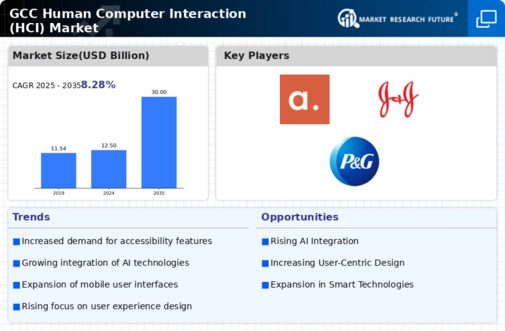Rising Demand for User-Centric Design
The Global GCC Human Computer Interaction Market (HCI) Market Industry experiences a notable surge in demand for user-centric design. Organizations increasingly recognize the importance of creating intuitive interfaces that enhance user experience. This trend is driven by the growing reliance on digital platforms across various sectors, including education and healthcare. As a result, companies are investing in HCI solutions that prioritize usability and accessibility. The market is projected to reach 12.5 USD Billion in 2024, reflecting a robust interest in improving user engagement through innovative design methodologies.
Emergence of Virtual and Augmented Reality
The emergence of virtual and augmented reality technologies is transforming the Global GCC Human Computer Interaction Market (HCI) Market Industry. These immersive technologies offer new avenues for user interaction, enabling experiences that were previously unimaginable. Industries such as gaming, education, and training are leveraging VR and AR to create engaging environments that enhance learning and retention. As these technologies become more mainstream, the demand for effective HCI solutions will likely increase, further propelling market growth. The integration of VR and AR into everyday applications signifies a pivotal shift in how users engage with digital content.
Increased Investment in Smart Technologies
The Global GCC Human Computer Interaction Market (HCI) Market Industry is witnessing increased investment in smart technologies, such as IoT devices and wearables. These innovations are reshaping how users interact with their environments, leading to more seamless and integrated experiences. For example, smart home devices allow users to control various aspects of their living spaces through intuitive interfaces. This trend is likely to drive market growth, with a projected CAGR of 8.28% from 2025 to 2035. As smart technologies become more prevalent, the demand for effective HCI solutions will continue to rise.
Growing Focus on Accessibility and Inclusivity
A growing focus on accessibility and inclusivity is shaping the Global GCC Human Computer Interaction Market (HCI) Market Industry. Organizations are increasingly aware of the need to design interfaces that cater to diverse user groups, including those with disabilities. This shift is prompting the development of HCI solutions that prioritize universal design principles. By ensuring that digital products are accessible to all, companies can enhance user satisfaction and broaden their customer base. As this trend gains momentum, the market is expected to expand, reflecting a commitment to inclusivity in technology.
Technological Advancements in AI and Machine Learning
Technological advancements in artificial intelligence and machine learning significantly influence the Global GCC Human Computer Interaction Market (HCI) Market Industry. These technologies enable more sophisticated interactions between users and systems, facilitating personalized experiences. For instance, AI-driven chatbots and virtual assistants are becoming commonplace, enhancing customer service across various sectors. As organizations adopt these technologies, the market is expected to grow substantially, with projections indicating a rise to 30 USD Billion by 2035. This growth is indicative of the potential for AI to transform user interactions and streamline processes.














Leave a Comment